Bowser N5 Cabin Car
Published: 2021-11-15 - By: CNW400
Last updated on: 2021-11-18
Last updated on: 2021-11-18
visibility: Public - Headline
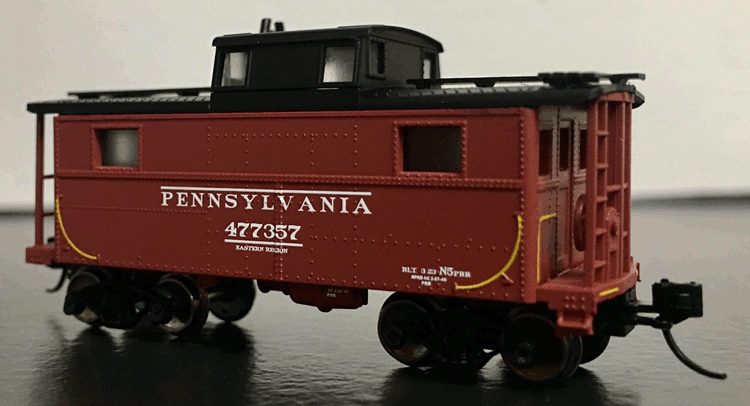
In July 2021 Bowser Trains released their latest N5 cabin car series into their extensive caboose collection. Six different road names were released in various paint schemes:
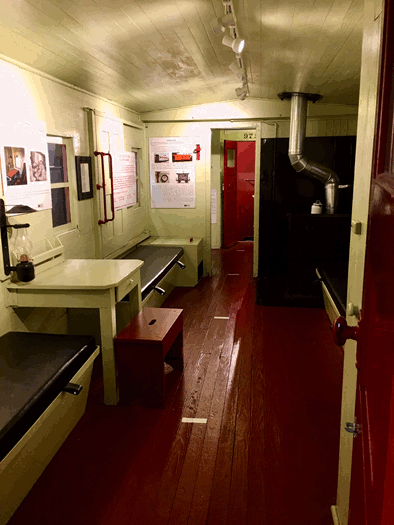
Caboose Interior (Koltz)
The caboose also served as the conductor’s office and included his work desk, storage lockers, stove for heating & cooking, toilet and sleeping accommodations - for many crewmembers, the caboose was ‘their home away from home’ and was embellished with many personal items.
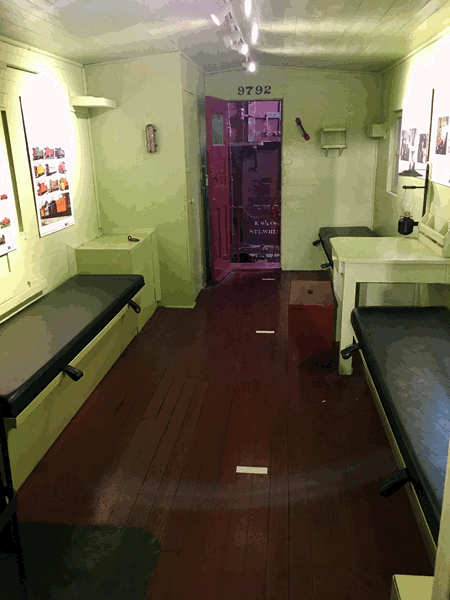
Life Aboard a Caboose (Koltz)
The early caboose was first constructed with wood before evolving into steel panels. The cupola offered a full view of running conditions from above. The cupola, a small window structure atop the caboose roof for crews to monitor the train and track conditions, was fitted with seats usually assigned to a crewmember such as brakeman or conductor.
.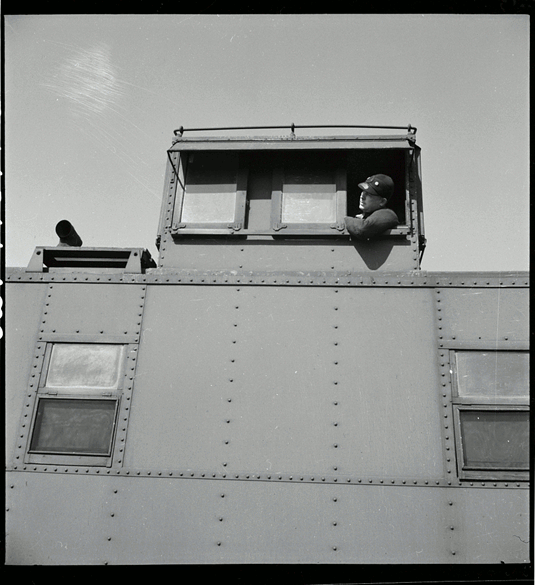
Library of Congress Prints and Photographs Division Washington, D.C. 20540 USA – Public Domain
Delano, Jack, photographer. Marceline, Missouri. Brakeman in the cupola of his caboose in the Atchison, Topeka, and Santa Fe Railroad yard. United States Marceline Linn County Missouri, 1943. Mar. Photograph
https://www.loc.gov/item/2017847523/
The Pennsylvania Railroad (PRR) produced the first all steel caboose in 1914...termed ‘cabin cars’ by PRR crewmembers, the N5 Class caboose basic design was a fixture for the railroad until the mid-1940's. Any subsequent models with variations or modifications were assigned a letter suffix. The Pennsylvania Railroad built 638 N5 cabin cars over the next 15 years at their Altoona, PA or Hollidaysburg, PA shops. The Pennsylvania Railroad Historical Society revealed that a N5 cabin car in 1923 cost $3,300 to build.
The N5 cars were originally painted ‘Freight Car Color’ (a more red than brown version of the common boxcar). The interiors were colored a light green. Photographic evidence shows that the trucks were painted either black or Freight Car Color. Lettering was white and centered on the cabin car body – the lettering may appear off-centered due to the location of the cupola. The ‘One-Stripe’ scheme was first used with a large Pennsylvania road name on the side of the cabin with a single underlining stripe and road number centered below the stripe. Furthermore, the initial design was manufactured with arch bar trucks, an undermount toolbox, KD braking system and stove & bathroom located at opposite ends of the cabin. Arch bar trucks, commonly used in the 1890’s thru 1920’s, were pressed steel parts that were bolted together. The excessive weight of freight cars and the harsh wear-n-tear on the railcar trucks and wheels required these components to undergo repair and tightening of hardware often. Seen as a safety hazard and with further advancements in rail equipment, the use of arch bar trucks was banned from all interchange service in 1940.
Later modifications to the N5 included the KD brakes being replaced with a Westinghouse “AB” Air Brake system, Ajax brake wheels were used instead of brake levers, removal of the underside toolbox, addition of twin collision posts on the car ends, installation of safety glass and the stove & bathroom moved closer to the center of the car under the cupola. The relocation of the facilities also positioned the smoke jack and bathroom vent nearer to the center of the caboose.
Close-Up of End Platform Caboose Brake Wheel (Koltz)
The AB system was a straightforward design with a brake cylinder, valve, and reservoir. A COTS or COT&S numbers were stenciled on the brake system air reservoir. Also referred to as ’Clean, Oil, Test & Stencil’, the COT&S recorded the axle bearings and air brake system annual inspection and lubrication data.
In the 1926 the ‘Two-Stripe’ scheme was introduced with a large stripe above the road name and a smaller stripe below the road number. Built date, class and repack data was stenciled in the lower right corner. Repack indicates that the wheel journals have been changed – overheated journals can cause a hotbox. In short, a hotbox is when an axle bearing overheats and has the potential of igniting a fire. During the late 1940’s the N5 roofs and cupolas were painted black or tarred black for weather protection. Handrails and corner grab irons were painted yellow. The region assignment was added to the side panel below the second stripe. The ensuing class releases were nearly identical to the original N5 cabin car. The N5A was built in 1937 with Duryea cushion underframes. In 1941, 200 N5B cars were built with a variation in grab iron placements.
With the nation heading towards a wartime economy and the increased demand in freight rail traffic, the Pennsylvania Railroad designed the distinctive N5C cabin cars. During 1942 the PRR built 169 N5C cars with a centered aerodynamic streamlined cupola and replaced the rectangular cabin windows with four portholes on each side fitted with battleship-grade glass.
A considerable number of N5 Class cabin cars survived and served the Pennsylvania Railroad successors - the Penn Central Transportation Company (1968-1976) and the Consolidated Rail Corporation (Conrail 1976-1999). Before that time of succession, the N5 cabin car experienced some cosmetic transformations.
In the winter of 1955, the Shadow Keystone scheme was applied to the N5 series cars (PRR logo with a black ‘shadow’). All roofs and trucks were painted black. During the early 1960’s, cabin cars assigned to pool service had their cupola painted yellow. A pool service car is not assigned to a particular terminal or crew but is used anywhere throughout the system. Cabin cars appointed to electrified pool service had their cupola painted grey. Finally in 1965, the Pennsylvania Railroad gave their cars their last splash of color before the merger with a coat of Focal Orange. (Source for color schemes: www.pennsyrr.com).
The caboose met its demise in the early 1980’s with relaxed safety laws and modern technology. In 1982, the Railway Labor Act directed United States railroads to dispose of cabooses as soon as possible. Amongst other advancements: lineside defect detectors are used to spot hot boxes, the End of Train Device (EOT) was developed and attached to the last car to monitor air brake pressure and emit a flashing red light to warn trailing traffic of a train ahead and dispatch-controlled switches phased out the need to manually throw switches. The need for the caboose was eliminated. The few caboose cars that are still in service today are used for maintenance of way (MOW), as a shoving platform on industrial spur lines that perform long reverse moves & heavy switching or on tourist/museum railroads.
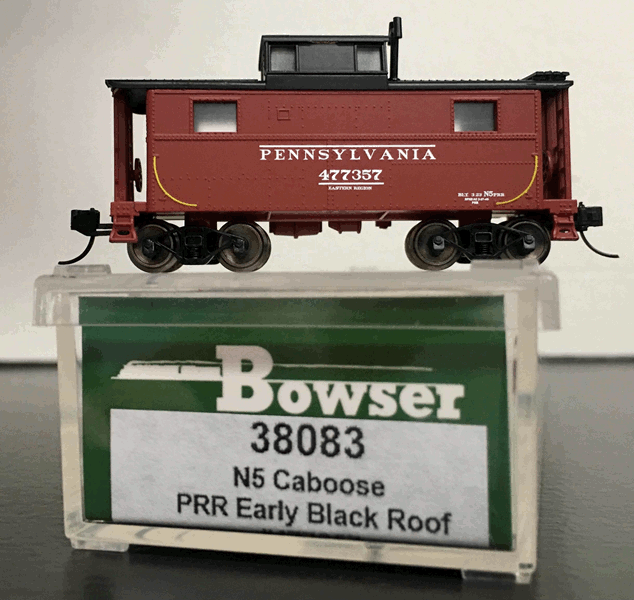
Model with acrylic box
The paint job is clean and even along the entire injection molded plastic model with a separately attached roof. The Pennsylvania cabin car is painted Freight Car Color with white lettering and the roof is colored black. The body appears to have more of a brown tone when compared to photographs of other N5 cabin cars which exhibit a redder hue...nothing to complain about - just making an observation.
The steel panel body displays well defined rivet patterns and the prototype correct two rectangular side windows configuration. The stamping is extremely sharp and clean – all characters are neat and legible, even when magnification is needed to read the smaller print. The ‘Two-Stripe’ scheme is represented with the Eastern Region assignment noted on the road number. The built date, class, owner and repack date (2-27-49) are stenciled in the lower right corner. The arrangement of this data differed depending on which shop applied the stencil and varies on prototype photographs. This cabin car was built in 1923 by the Pennsylvania Railroad shop in Altoona, Pennsylvania.
Underwhelming features include the curved chrome yellow handrails that are flat, molded elements instead of separately applied detail pieces. Also, the lack of interior features visible through the frosted glass windows – just a plain white box inside the cabin car. But Bowser scored points for featuring all three attachments points on the curved side rails.
Sharp Printing and Rivet Detail.
Note Three Attachment Points on Curved Rail and Pin Hole on Deck.
Both molded end platforms feature era correct twin collision posts mounted in front of the center door, left side end ladder, platform steps and Ajax brake wheel. The center door with single side windows is prototypical correct, along with the chrome yellow railings and PRR stenciled above the door. An unsatisfactory feature is the coupler pin hole being visible on the platform deck. According to my research, the deck should be modeled as wood not a flat steel platform.
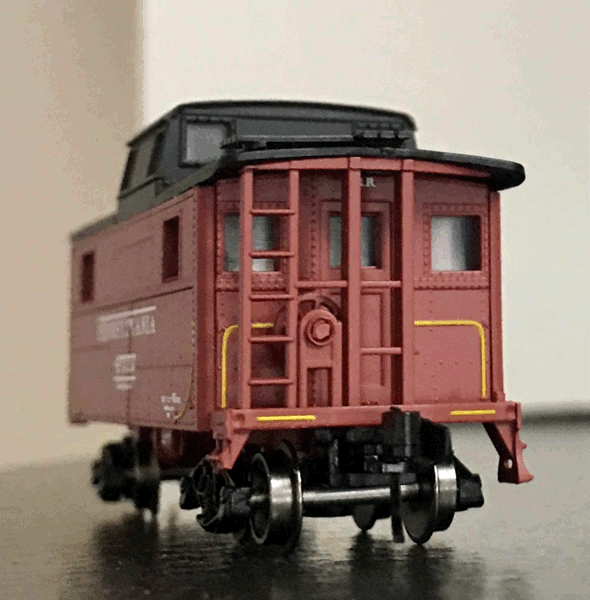
Molded Ladder and Collison Posts. Prototypical Correct Brake Wheel

Prototype Appropriate Yellow Railings and PRR Above Door
The riveted black steel roof features an off-centered double window cupola, prototype correct extended wooden running boards, lateral running boards and near center smoke jack. The smoke jack is properly aligned with the relocated stove in later versions of the N5 cabin car. The Bowser model has a ‘H’ style smoke jack, while not incorrect, the simple vertical pipe with cap was the more common variety for the N5 car.
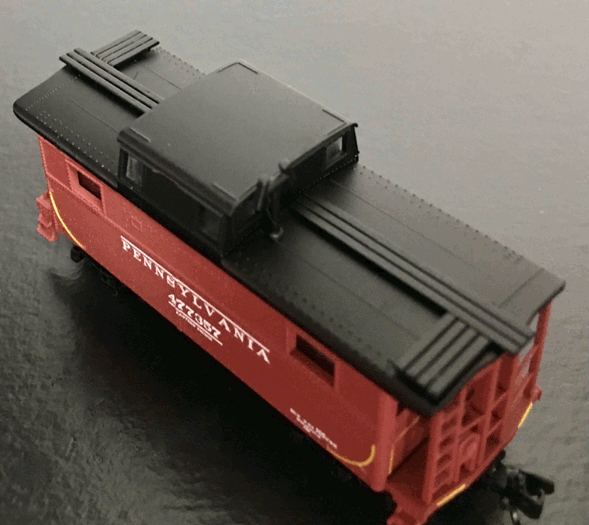
Rivet Steel Roof with Off-Center Cupola, Running Boards and ‘H’ Style Smoke Jack
The underframe has minimal detail with a molded AB braking system featuring a brake cylinder, valve, and reservoir. One nice feature is the COT&S data stenciled on the reservoir – magnification is required to clearly read (AC 2-27-49 PRR). The cabin car is fitted with proper height body mounted knuckle spring couplers and Fox Valley Models 33” metal wheels.
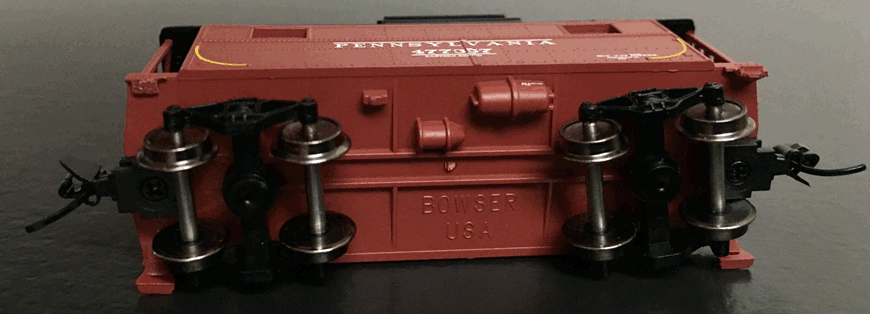
Molded AB Brake System. Fox Valley Model Metal Wheels
The caboose is 2 1/8 inches in length and weighs about 0.5 ounces, which is light according to the National Model Railroad Association (NMRA) recommendations (which are 0.80 - 0.85 ounces for this size car). But I did find it an exceptional runner while testing the car on Kato Unitrack with no issues around curves or through turnouts at slow and medium speeds.
Bowser offers a non-fancy, fair depiction of the Pennsylvania N5 cabin car - a mostly prototypical accurate model that lacks some of the features taken for granted by the modern modeler (separately applied parts, interior details, unmolded parts, etc.). If you are further interested in the Bowser Trains caboose, there is a YouTube video available (Behind the Scenes Tour of the Bowser Model Train Company) that explains the manufacturing steps in the production of this fine American made (assembled overseas) model railroad collection.
To see a list of all cars in this series, CLICK HERE.
- Boston & Maine (Minute Man)
- Conrail (MOW) (1 road number available)
- Conrail
- Penn Central
- PRR (Early Scheme with Train Phone)
- PRR (Early Scheme with Black Roof)
- PRR (Keystone - Focal Orange / 1 road number available)
- PRR (Keystone with Yellow Cupola)
- PRR (Keystone with Black Cupola)
- PRR (Shadow Keystone - Lake Region)
- PRR (Shadow Keystone – Railway Express Agency)
- Pennsylvania-Reading Seashore Lines
- Reading & Northern (1 road number available)
Prototype History
The caboose was a North American railcar placed at the end of a freight train to provide shelter for crew members needed for switching and braking operations, observing for a shift of load or damage to equipment, monitoring for hot boxes and protecting the rear of train when stopped.
The caboose also served as the conductor’s office and included his work desk, storage lockers, stove for heating & cooking, toilet and sleeping accommodations - for many crewmembers, the caboose was ‘their home away from home’ and was embellished with many personal items.

The early caboose was first constructed with wood before evolving into steel panels. The cupola offered a full view of running conditions from above. The cupola, a small window structure atop the caboose roof for crews to monitor the train and track conditions, was fitted with seats usually assigned to a crewmember such as brakeman or conductor.
.

Delano, Jack, photographer. Marceline, Missouri. Brakeman in the cupola of his caboose in the Atchison, Topeka, and Santa Fe Railroad yard. United States Marceline Linn County Missouri, 1943. Mar. Photograph
https://www.loc.gov/item/2017847523/
The Pennsylvania Railroad (PRR) produced the first all steel caboose in 1914...termed ‘cabin cars’ by PRR crewmembers, the N5 Class caboose basic design was a fixture for the railroad until the mid-1940's. Any subsequent models with variations or modifications were assigned a letter suffix. The Pennsylvania Railroad built 638 N5 cabin cars over the next 15 years at their Altoona, PA or Hollidaysburg, PA shops. The Pennsylvania Railroad Historical Society revealed that a N5 cabin car in 1923 cost $3,300 to build.
The N5 cars were originally painted ‘Freight Car Color’ (a more red than brown version of the common boxcar). The interiors were colored a light green. Photographic evidence shows that the trucks were painted either black or Freight Car Color. Lettering was white and centered on the cabin car body – the lettering may appear off-centered due to the location of the cupola. The ‘One-Stripe’ scheme was first used with a large Pennsylvania road name on the side of the cabin with a single underlining stripe and road number centered below the stripe. Furthermore, the initial design was manufactured with arch bar trucks, an undermount toolbox, KD braking system and stove & bathroom located at opposite ends of the cabin. Arch bar trucks, commonly used in the 1890’s thru 1920’s, were pressed steel parts that were bolted together. The excessive weight of freight cars and the harsh wear-n-tear on the railcar trucks and wheels required these components to undergo repair and tightening of hardware often. Seen as a safety hazard and with further advancements in rail equipment, the use of arch bar trucks was banned from all interchange service in 1940.
Later modifications to the N5 included the KD brakes being replaced with a Westinghouse “AB” Air Brake system, Ajax brake wheels were used instead of brake levers, removal of the underside toolbox, addition of twin collision posts on the car ends, installation of safety glass and the stove & bathroom moved closer to the center of the car under the cupola. The relocation of the facilities also positioned the smoke jack and bathroom vent nearer to the center of the caboose.

The AB system was a straightforward design with a brake cylinder, valve, and reservoir. A COTS or COT&S numbers were stenciled on the brake system air reservoir. Also referred to as ’Clean, Oil, Test & Stencil’, the COT&S recorded the axle bearings and air brake system annual inspection and lubrication data.
In the 1926 the ‘Two-Stripe’ scheme was introduced with a large stripe above the road name and a smaller stripe below the road number. Built date, class and repack data was stenciled in the lower right corner. Repack indicates that the wheel journals have been changed – overheated journals can cause a hotbox. In short, a hotbox is when an axle bearing overheats and has the potential of igniting a fire. During the late 1940’s the N5 roofs and cupolas were painted black or tarred black for weather protection. Handrails and corner grab irons were painted yellow. The region assignment was added to the side panel below the second stripe. The ensuing class releases were nearly identical to the original N5 cabin car. The N5A was built in 1937 with Duryea cushion underframes. In 1941, 200 N5B cars were built with a variation in grab iron placements.
With the nation heading towards a wartime economy and the increased demand in freight rail traffic, the Pennsylvania Railroad designed the distinctive N5C cabin cars. During 1942 the PRR built 169 N5C cars with a centered aerodynamic streamlined cupola and replaced the rectangular cabin windows with four portholes on each side fitted with battleship-grade glass.
A considerable number of N5 Class cabin cars survived and served the Pennsylvania Railroad successors - the Penn Central Transportation Company (1968-1976) and the Consolidated Rail Corporation (Conrail 1976-1999). Before that time of succession, the N5 cabin car experienced some cosmetic transformations.
In the winter of 1955, the Shadow Keystone scheme was applied to the N5 series cars (PRR logo with a black ‘shadow’). All roofs and trucks were painted black. During the early 1960’s, cabin cars assigned to pool service had their cupola painted yellow. A pool service car is not assigned to a particular terminal or crew but is used anywhere throughout the system. Cabin cars appointed to electrified pool service had their cupola painted grey. Finally in 1965, the Pennsylvania Railroad gave their cars their last splash of color before the merger with a coat of Focal Orange. (Source for color schemes: www.pennsyrr.com).
The caboose met its demise in the early 1980’s with relaxed safety laws and modern technology. In 1982, the Railway Labor Act directed United States railroads to dispose of cabooses as soon as possible. Amongst other advancements: lineside defect detectors are used to spot hot boxes, the End of Train Device (EOT) was developed and attached to the last car to monitor air brake pressure and emit a flashing red light to warn trailing traffic of a train ahead and dispatch-controlled switches phased out the need to manually throw switches. The need for the caboose was eliminated. The few caboose cars that are still in service today are used for maintenance of way (MOW), as a shoving platform on industrial spur lines that perform long reverse moves & heavy switching or on tourist/museum railroads.

The Model
The ready-to-run cabin car comes packaged in an oversized clear plastic jewel case with a pop-off cover and a one-piece plastic cradle to support the model. The model information is clearly labeled on the end of the case for ease to locate when in storage. A thin sticky plastic film covered the top of the caboose to protect the car from scratches. I did notice that one of the platform steps had broken-off and was jiggling inside the case... should be a simple repair.
The paint job is clean and even along the entire injection molded plastic model with a separately attached roof. The Pennsylvania cabin car is painted Freight Car Color with white lettering and the roof is colored black. The body appears to have more of a brown tone when compared to photographs of other N5 cabin cars which exhibit a redder hue...nothing to complain about - just making an observation.
The steel panel body displays well defined rivet patterns and the prototype correct two rectangular side windows configuration. The stamping is extremely sharp and clean – all characters are neat and legible, even when magnification is needed to read the smaller print. The ‘Two-Stripe’ scheme is represented with the Eastern Region assignment noted on the road number. The built date, class, owner and repack date (2-27-49) are stenciled in the lower right corner. The arrangement of this data differed depending on which shop applied the stencil and varies on prototype photographs. This cabin car was built in 1923 by the Pennsylvania Railroad shop in Altoona, Pennsylvania.
Underwhelming features include the curved chrome yellow handrails that are flat, molded elements instead of separately applied detail pieces. Also, the lack of interior features visible through the frosted glass windows – just a plain white box inside the cabin car. But Bowser scored points for featuring all three attachments points on the curved side rails.

Note Three Attachment Points on Curved Rail and Pin Hole on Deck.
Both molded end platforms feature era correct twin collision posts mounted in front of the center door, left side end ladder, platform steps and Ajax brake wheel. The center door with single side windows is prototypical correct, along with the chrome yellow railings and PRR stenciled above the door. An unsatisfactory feature is the coupler pin hole being visible on the platform deck. According to my research, the deck should be modeled as wood not a flat steel platform.


The riveted black steel roof features an off-centered double window cupola, prototype correct extended wooden running boards, lateral running boards and near center smoke jack. The smoke jack is properly aligned with the relocated stove in later versions of the N5 cabin car. The Bowser model has a ‘H’ style smoke jack, while not incorrect, the simple vertical pipe with cap was the more common variety for the N5 car.

The underframe has minimal detail with a molded AB braking system featuring a brake cylinder, valve, and reservoir. One nice feature is the COT&S data stenciled on the reservoir – magnification is required to clearly read (AC 2-27-49 PRR). The cabin car is fitted with proper height body mounted knuckle spring couplers and Fox Valley Models 33” metal wheels.

The caboose is 2 1/8 inches in length and weighs about 0.5 ounces, which is light according to the National Model Railroad Association (NMRA) recommendations (which are 0.80 - 0.85 ounces for this size car). But I did find it an exceptional runner while testing the car on Kato Unitrack with no issues around curves or through turnouts at slow and medium speeds.
Bowser offers a non-fancy, fair depiction of the Pennsylvania N5 cabin car - a mostly prototypical accurate model that lacks some of the features taken for granted by the modern modeler (separately applied parts, interior details, unmolded parts, etc.). If you are further interested in the Bowser Trains caboose, there is a YouTube video available (Behind the Scenes Tour of the Bowser Model Train Company) that explains the manufacturing steps in the production of this fine American made (assembled overseas) model railroad collection.
To see a list of all cars in this series, CLICK HERE.

